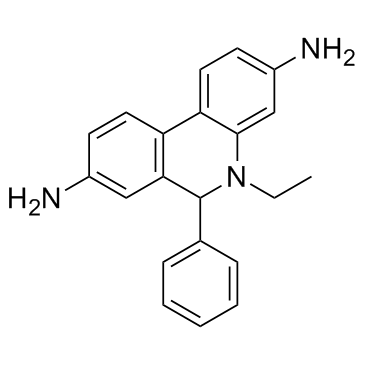1239-45-8
| Name | ethidium bromide |
|---|---|
| Synonyms |
3,8-Diamino-5
MFCD00011724 3,8-Diamino-5-ethyl-6-phenylphenanthridinium bromide,EtBr,Homidium bromide Phenanthridinium, 3,8-diamino-5-ethyl-6-phenyl-, bromide (1:1) Homidium bromide 3,8-Diamino-5-ethyl-6-phenylphenanthridin-5-ium bromide 3,8-Diamino-5-ethyl-6-phenylphenanthridinium bromide EINECS 214-984-6 5-ethyl-6-phenylphenanthridin-5-ium-3,8-diamine,bromide EthidiuM BroMide |
| Description | Ethidium bromide is an intercalating agent commonly used as a fluorescent tag (nucleic acid stain) in molecular biology laboratories for techniques such as agarose gel electrophoresis. |
|---|---|
| Related Catalog | |
| In Vitro | Guidelines (Following is our recommended protocol. This protocol only provides a guideline, and should be modified according to your specific needs). The preparation of agarose gel: 1. Agarose gels are commonly used in concentrations of 0.5% to 2.5% depending on the size of bands needed to be separated. 2. Mix the agarose powder with 1X TAE/TBE. 3. Microwave for 1-3 min until the agarose is completely dissolved (Caution: not overboil). 4. Make the solution cool down before solidification. 5. Add ethidium bromide (EtBr) to a final concentration of approximately 0.2-0.5 μg/mL (Stocks are generally 10 mg/ml, and require 5 µL stock/100 mL gel). 6. Ethidium bromide binds to the DNA and you could visualize the DNA under ultraviolet (UV) light. CAUTION: EtBr is a known mutagen. Please pay attention to strengthening protection. |
| References |
| Melting Point | 260-262 °C (dec.)(lit.) |
|---|---|
| Molecular Formula | C21H20BrN3 |
| Molecular Weight | 394.308 |
| Flash Point | >100°C |
| Exact Mass | 393.084045 |
| PSA | 55.92000 |
| LogP | 2.29820 |
| Index of Refraction | 1.4575 (20ºC) |
| Storage condition | 2-8°C |
| Stability | Stable. Incompatible with strong oxidizing agents. |
| Water Solubility | 40 g/L (25 ºC) |
CHEMICAL IDENTIFICATION
HEALTH HAZARD DATAACUTE TOXICITY DATA
MUTATION DATA
|
| Symbol |


GHS06, GHS08 |
|---|---|
| Signal Word | Danger |
| Hazard Statements | H302-H330-H341 |
| Precautionary Statements | P260-P281-P284-P310 |
| Personal Protective Equipment | Eyeshields;Faceshields;full-face particle respirator type N100 (US);Gloves;respirator cartridge type N100 (US);type P1 (EN143) respirator filter;type P3 (EN 143) respirator cartridges |
| Hazard Codes | T+:Verytoxic; |
| Risk Phrases | R21/22;R26;R36/37/38;R68 |
| Safety Phrases | S36/37-S45-S36/37/39-S28A-S26-S22 |
| RIDADR | UN 2811 6.1/PG 1 |
| WGK Germany | 3 |
| RTECS | SF7950000 |
| Packaging Group | I |
| Hazard Class | 6.1 |
| HS Code | 29339990 |
| Precursor 9 | |
|---|---|
| DownStream 1 | |
| HS Code | 2933990090 |
|---|---|
| Summary | 2933990090. heterocyclic compounds with nitrogen hetero-atom(s) only. VAT:17.0%. Tax rebate rate:13.0%. . MFN tariff:6.5%. General tariff:20.0% |











